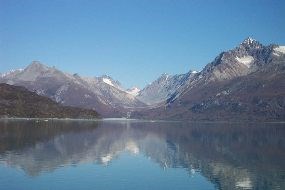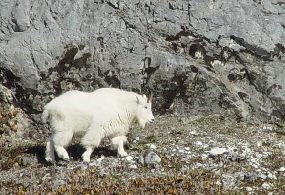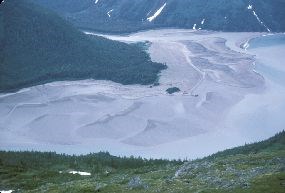
By 13,000 years ago, retreating ice revealed a scoured landscape of rounded hills and deep, U-shaped valleys and fjords. The precipitous peaks in this landscape were taller than the glacier was deep and so the glacial ice flowed around them. Unlike the lower peaks rounded and eroded by the glacier's force, these taller peaks remained jagged in appearance. The land was swept clean of valley sediments. During the Wisconsin Ice Age, the weight of the ice on the earth’s crust was so great it pushed the crust down several hundred feet into the semi-liquid mantle. As the ice melted and the weight relieved, the earth’s crust began to spring back in a phenomenon known as “isostatic rebound.” 
A few species of plants and animals enduring frigid arctic conditions near the glaciers may have survived to recolonize the land as the ice retreated. For the most part, however, life had to return from afar. Plants and animals overcame physical barriers such as saltwater, mountains and the remaining ice fields to get here. It's believed mountain goats may have been the first land mammals to find their way into the bay by crossing the mountains from the Lynn Canal area. All of Glacier Bay's new immigrants had to cope with ecological barriers such as cold temperatures, lack of water, inadequate food sources and poor soils. Living conditions in Glacier Bay continued to be harsh. Studies of pollen buried in lake sediments and bogs have provided a detailed record of the recovery of communities after the ice. For several thousand years, tundra and pine-alder scrub dominated the post-glacial landscape. By 9,000 years ago, spruce-hemlock forests had developed, suggesting that by then the climate was approaching the present wet and mild conditions. By 5,000 years ago, peat lands were forming along Icy Strait and glaciers were beginning to advance again into upper Glacier Bay. 
All the while, the physical landscape was undergoing changes of its own. Post-Great Ice Age isostatic rebound, mountain-building and accumulation of sediments washed down from the uplands began extending valley bottoms, filling in fjords and connecting islands to the mainland. Where these sediments met the sea, waves and currents worked them into beaches and estuaries. It’s speculated that at this time it was getting easier for land animals to get into the area and survive here. Breeding sites for colonial birds and marine mammals probably became fewer. Thus, as forest species like deer and black bear became better established, puffins and sea lions diminished. Salmon began to find their way to the developing streams. As of now, this story is very sketchily known, but deposits of animal bones in recently-discovered caves in southern Southeast Alaska have begun to provide a more detailed record of mammal and bird reoccupation of the land. This cave topography extends into the Glacier Bay area, but it remains almost totally unexplored at present. |
Last updated: December 28, 2015
